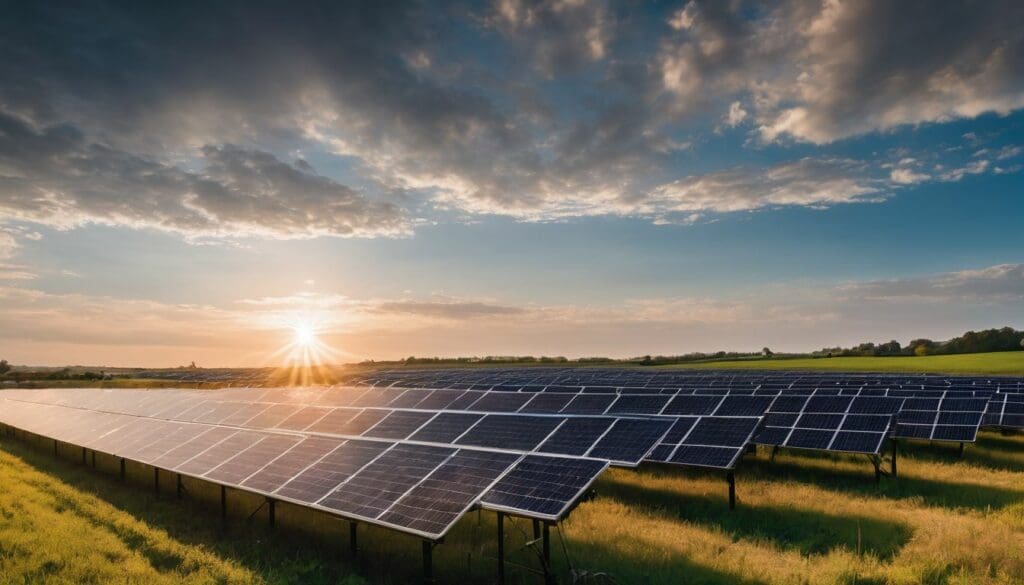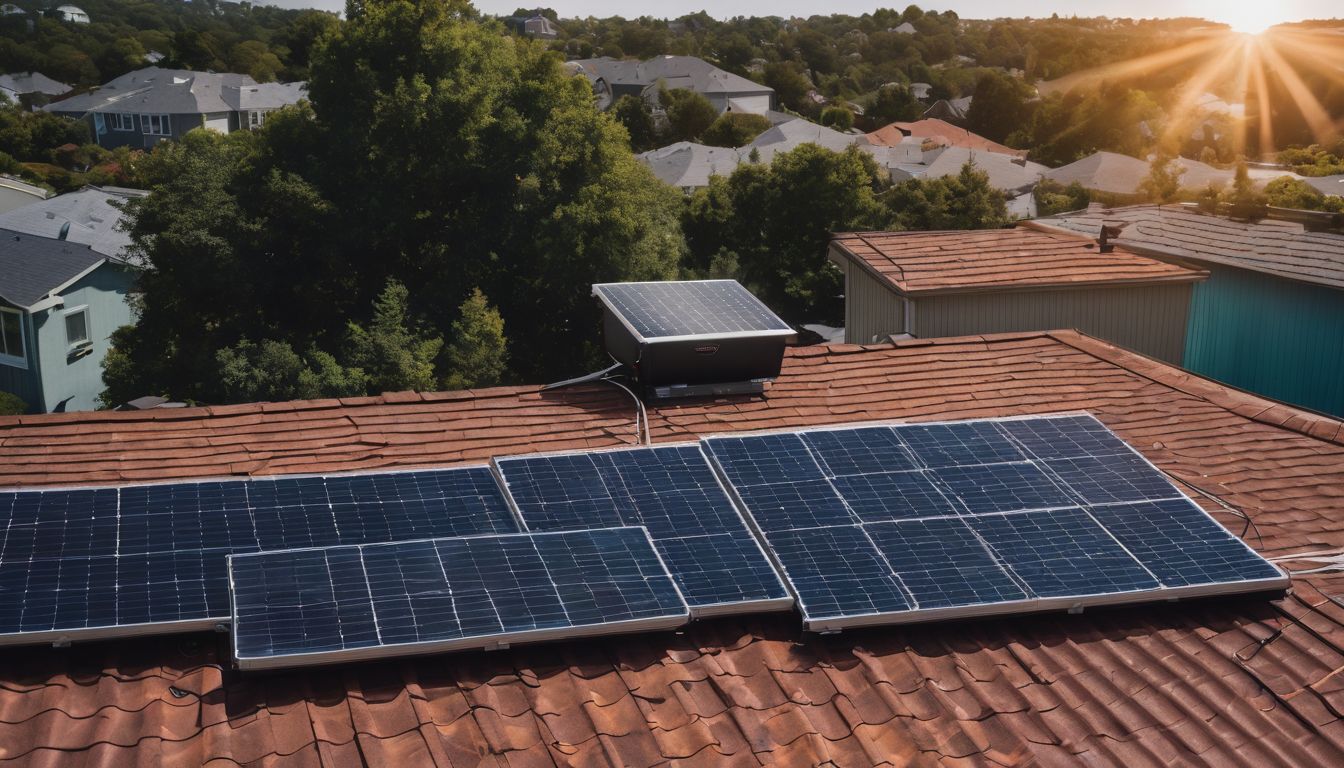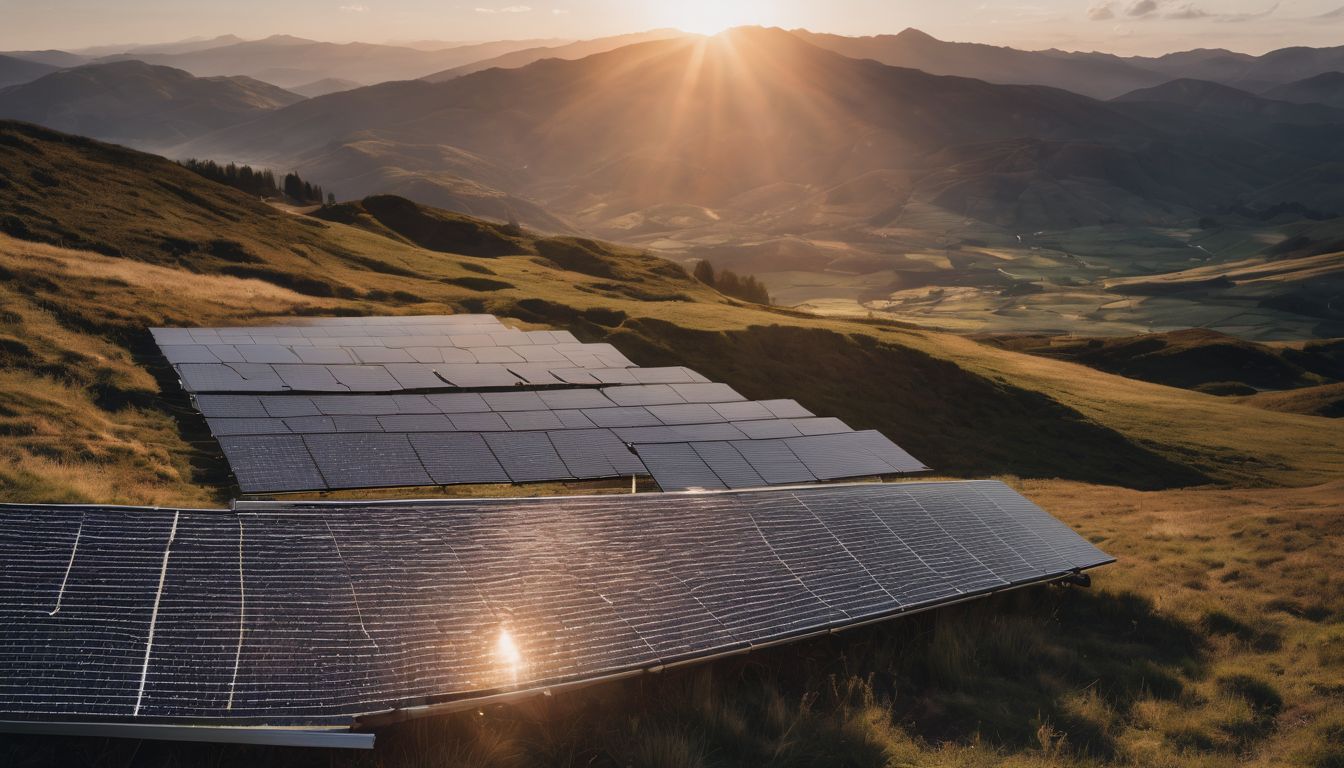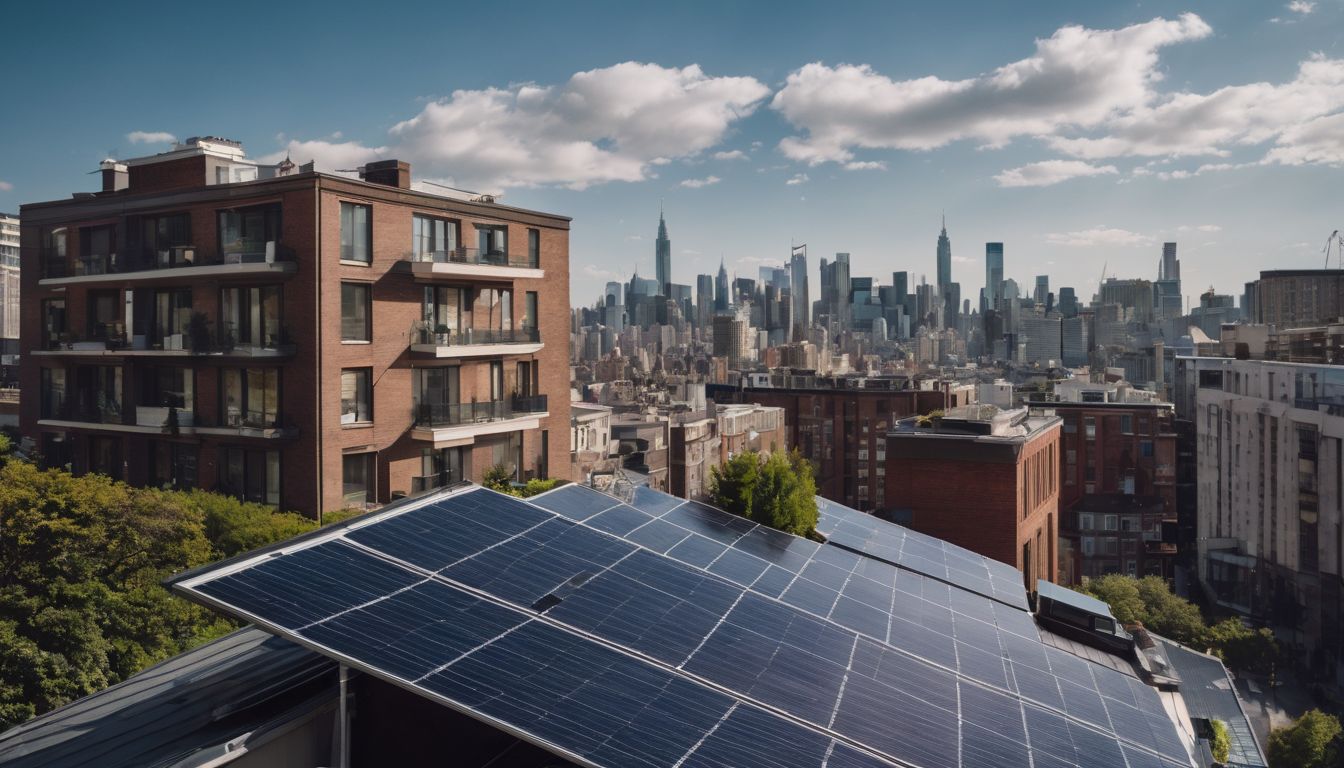Are your electricity bills soaring through the roof? Solar power harnesses the sun’s abundant energy, an increasingly popular renewable source that’s both clean and cost-effective.
This guide will illuminate the essentials of solar technology from panels to payback, equipping you with knowledge to tap into this sustainable power. Dive in and let’s brighten up your understanding!
Key Takeaways
- Solar panels convert sunlight into electricity using silicon cells, with different types like monocrystalline and polycrystalline offering varying efficiency levels.
- Components of a solar power system include panels, inverters, batteries for storage, and racking systems; design and size are tailored to energy needs and location.
- Installation costs in the UK range from £6,000 to £9,000 on average but can be offset by government incentives, with the potential to provide a solid return on investment through reduced bills.
- Advantages of solar power encompass lower energy costs and increased property value; its disadvantages include high upfront costs and dependence on weather conditions.
- Solar installations may impact home insurance policies; it’s advisable to check coverage specifics with providers.
The Basics of Solar Panels
Solar panels are made of silicon cells that convert sunlight into electricity. They work by allowing photons, or light particles, to knock electrons free from atoms, generating a flow of electricity.
Different types of solar panels include monocrystalline, polycrystalline, and thin-film panels. The efficiency of solar panels can vary based on their design and technology used.
What they are made of
Solar panels thrive on simplicity and efficiency. At their core, these devices consist of photovoltaic cells that convert sunlight into electricity. These cells are primarily made from silicon, a material known for its durable properties and excellent conductive capabilities.
Manufacturers sandwich a layer of positive-type silicon between two layers of negative-type silicon to create each solar cell.
Each panel includes multiple photovoltaic cells linked together, covered by glass for protection against the elements. An anti-reflective coating ensures that as much light as possible is absorbed rather than reflected away.
The entire assembly is contained within an aluminium frame that offers further durability while enabling easy installation onto rooftops or other structures.
Harnessing the sun’s power also involves understanding how these components come to life in your own system – which leads us to exploring ‘How they work’.
How they work
Solar panels work by converting sunlight into electricity using photovoltaic cells. When sunlight hits the solar panels, the photons in the light create an electric field across the layers of silicon within the cells, generating direct current (DC) electricity.
An inverter then converts this DC electricity into alternating current (AC), which is what powers most home appliances and goes back to your electrical panel to be used throughout your house.
The energy produced can either power your home directly or be fed back into the grid for a credit on your utility bill if you have a grid-tied system.
Different types
Solar panels come in various types, including monocrystalline, polycrystalline, and thin-film. Each type has its unique characteristics and performance levels. Monocrystalline panels are known for their high efficiency and sleek design.
On the other hand, polycrystalline panels offer a cost-effective option with slightly lower efficiency. Thin-film panels are lightweight and flexible, making them suitable for unconventional installation spaces such as curved surfaces or portable applications.
The different types of solar panels provide options to suit specific energy needs, space availability, and budget considerations. Understanding these variations can help individuals make informed decisions when choosing the most suitable solar panel type for their particular circumstances.
Efficiency
Solar panels vary in efficiency, with some converting sunlight into electricity more effectively than others. Factors such as the type of solar panel, its age, and environmental conditions can impact overall performance.
Photovoltaic panels are designed to capture solar radiation and convert it into usable energy. Regular maintenance and cleaning will help maintain their efficiency over time.
To maximise the effectiveness of your solar power system, it’s important to consider different types of solar panels available on the market. Each type has varying levels of efficiency, so it’s crucial to research which option suits your needs best.
Understanding Solar Energy Systems
Learn about the components of solar energy systems, the system design and size, as well as the installation process. Understanding these key elements will help you make informed decisions for your renewable energy needs.
Read on to delve deeper into the world of solar power systems.
Components (Panels, Inverters, Batteries, Racking)
Solar panels are made of photovoltaic cells that convert sunlight into electricity. Inverters play a crucial role in converting the direct current (DC) produced by solar panels into alternating current (AC) for use in homes. Batteries store excess energy generated by solar panels for use when the sun isn’t shining. Racking provides a stable and secure base for mounting solar panels on rooftops or open spaces.
System design and size
Solar energy systems are designed based on specific factors such as energy consumption, location, and roof size. The system’s design includes the number and type of solar panels, inverter capacity, battery storage (if applicable), and racking configuration to optimise sunlight exposure.
System size is determined by the amount of electricity needed to power a home or business, considering peak usage times and average energy consumption.
Designing an efficient solar system involves assessing the available space for panel installation and choosing the most suitable system layout. Factors like shading, orientation, and tilt angle impact design choices.
Installation process
To install a solar energy system at your home, follow these steps:
- Consultation with a solar provider: Contact a reputable solar company to discuss your energy needs and receive a customised assessment for your property.
- Permitting and paperwork: Obtain the necessary permits and complete any required paperwork for the installation of solar panels on your property.
- Pre-installation site visit: The solar provider will visit your property to assess the best location for the panels and ensure that the site is suitable for installation.
- Panel installation: The solar panels will be securely mounted on your roof or in another appropriate location on your property.
- Inverter and battery installation: The inverter, which converts the direct current (DC) electricity produced by the panels into alternating current (AC) electricity, as well as any battery storage systems, will be installed.
- Connection to the electrical grid: If you are opting for a grid-tied system, the solar provider will connect your system to the local electrical grid.
- System testing: After installation, the system will undergo thorough testing to ensure proper functionality and safety.
- Final inspection and approval: A final inspection will be conducted to ensure that your system meets all necessary regulations and standards before it is approved for use.
Cost and Financing of Solar Energy
The cost of installing a solar energy system can vary depending on factors such as the size of the system, type of panels, and installation costs. However, with tax credits and incentives available, along with financing options such as leases and loans, solar power can be a smart investment for eco-conscious homeowners.
Installation costs
Solar panel installation costs can vary depending on factors such as system size, equipment quality, and local labour rates. Typically, the average cost of installing a solar energy system in the UK ranges between £6,000 to £9,000 for a standard residential setup.
It is essential to get quotes from multiple accredited installers to ensure competitive pricing and quality workmanship. Additionally, homeowners may be eligible for government incentives or financing options that can help offset some of the upfront installation costs.
When considering installation expenses for solar power systems, it’s important to factor in potential long-term savings and environmental benefits alongside initial expenditure. By understanding the specific costs involved and leveraging available financial support mechanisms, individuals can make informed decisions about integrating clean energy solutions into their homes while contributing positively towards sustainable living practices.
Return on investment
Solar power systems can provide a strong return on investment over time. By reducing or eliminating monthly electricity bills, homeowners can start seeing savings as soon as their solar panels are installed and start producing energy.
Tax credits, incentives, and net metering programs further improve the financial benefits of solar power. With the right financing options available, the initial investment in solar panels can often be recouped within just a few years, making it a financially-sound decision for environmentally conscious individuals seeking long-term cost savings and sustainable energy solutions.
Understanding the cost and financing of solar energy is crucial for making an informed decision about harnessing renewable energy from the sun. Next up – “Benefits and Drawbacks of Solar Power” presents a comprehensive overview to assist in your journey towards sustainable living.
Tax credits and incentives
When installing a solar energy system, homeowners can take advantage of tax credits and incentives. These financial benefits help offset the initial investment and encourage the adoption of renewable energy.
By leveraging these incentives, individuals can significantly reduce the overall cost of installing solar panels on their property.
For environmentally conscious consumers, exploring tax credits and incentives is an essential step in understanding the long-term financial benefits of switching to solar power. It’s important to research available programs at both local and national levels to make informed decisions about financing a sustainable energy solution.
Financing options
After considering tax credits and incentives, the next step is to explore financing options for solar power systems. There are various ways to fund a solar installation, such as cash payment, loans, leasing, or Power Purchase Agreements (PPAs).
Cash payments offer immediate ownership of the system and maximise long-term savings. Loans provide an opportunity to spread out the initial investment over time while still benefiting from energy cost reduction.
Leasing allows access to solar energy without owning the system outright, while PPAs involve purchasing electricity produced by a third-party provider at a predetermined rate.
Benefits and Drawbacks of Solar Power
Solar power has numerous benefits such as reducing electricity bills, decreasing carbon footprint, and increasing home value. However, drawbacks include high initial costs and reliance on sunlight.
Want to learn more? Keep reading our blog for a deeper understanding of solar power!
Advantages
Solar power offers numerous advantages for environmentally conscious individuals. Firstly, solar energy is a clean and renewable source of power, reducing reliance on non-renewable resources like coal and natural gas.
This not only lowers carbon emissions but also helps in the fight against climate change. Additionally, solar panels can significantly reduce electricity bills by generating free electricity during daylight hours.
Moreover, solar panel installation can increase the value of your home while offering long-term savings. Furthermore, with advancements in technology and increasing awareness about environmental issues, solar power is becoming more affordable and accessible to homeowners.
Disadvantages
Solar power is not without disadvantages, one of which is the high initial installation cost. Additionally, solar panels require ample space and a suitable location for optimal energy production.
The reliance on sunlight also means that solar energy generation diminishes during cloudy or rainy weather, affecting its consistency as a power source. Moreover, there are environmental concerns related to the manufacturing process and disposal of solar panels.
Finally, despite advancements in battery storage technology, they still pose an added expense and can be bulky in size.
Impact on home value
Solar power can significantly increase the value of a home. Properties equipped with solar panels are increasingly attractive to buyers, as they offer long-term energy savings and potential tax incentives.
Studies show that homes with solar power systems tend to sell faster and at higher prices than those without, making it a worthwhile investment for homeowners looking to boost their property value.
The installation of solar panels often reflects positively on a home’s environmental credentials, appealing to environmentally conscious individuals who are willing to pay a premium for sustainable features.
Insurance implications
When considering solar power, it’s essential to review your homeowner’s insurance policy. Solar panels are generally covered under your standard home insurance, but it’s advisable to check for any specific terms or conditions related to alternative energy installations.
Contacting your insurance provider is crucial in understanding coverage, potential restrictions or adjustments needed. It’s important to ensure that your new system is financially protected against unexpected events such as damage from weather, theft, or accidents.
Moreover, some insurers offer specialised policies for renewable energy installations including solar panels. These policies may provide more comprehensive coverage and protection tailored specifically to the needs of solar power systems.
Frequently Asked Questions about Solar Power
– What is net metering and how does it work with solar power systems?
– How do grid-tied and off-grid systems differ in terms of solar energy usage?
– What kind of maintenance is required for solar panels?
– How does the local climate impact the effectiveness of solar power systems?
Net metering
With net metering, any excess electricity generated by your solar panels is sent back to the grid, and you receive credits for the power you contribute. These credits can offset the cost of electricity when your system isn’t producing enough energy.
This means that during peak sunlight hours, your solar panels may produce more energy than you need, allowing you to bank that extra power for later use or receive compensation for it.
Whether you have an on-grid or off-grid solar system, net metering provides a way to maximise the benefits of your solar investment. By contributing clean energy to the grid and receiving credits in return, homeowners not only reduce their electricity bills but also play a role in promoting sustainability and environmental conservation.
Grid-tie vs off-grid systems
Grid-tie systems connect to the local electrical grid, allowing homeowners to use solar power alongside the traditional utility supply. These systems can feed excess energy back into the grid, earning credits or payment through net metering.
Ongrid systems are well-suited for users who want to reduce their electricity bills and support renewable energy without needing backup power during outages.
Off-grid systems operate independently of the utility grid, relying on battery storage to provide electricity when solar panels aren’t producing enough power. Offgrid solar setups are ideal for remote locations or individuals seeking complete energy independence, but they require careful planning and maintenance due to limited battery capacity and reliance on solar power alone.
Maintenance requirements
After choosing between grid-tie and off-grid systems, it’s essential to understand the maintenance requirements of solar power. Regular cleaning of solar panels is crucial for optimal energy generation.
This involves removing dust, dirt, and debris that may accumulate over time. Additionally, checking the system for any potential shading issues and ensuring proper wiring connections are important preventive measures to maintain efficiency.
Periodic inspection by a professional can help identify any issues before they escalate, ensuring the system operates smoothly. Battery storage systems also require attention to maintain their performance and longevity.
Impact of local climate
When considering solar power, it’s essential to factor in the local climate. The amount of sunlight your location receives directly affects the efficiency of solar panels. Areas with high levels of sunshine are more conducive to solar energy production, making them ideal for harnessing the power of the sun.
Conversely, regions prone to frequent cloud cover or shorter daylight hours may experience lower energy generation from solar panels.
Understanding how your local climate impacts solar power can help you make informed decisions about system size and expected energy output. By assessing your region’s specific weather patterns and sunlight availability, you can optimise your solar energy system for maximum performance and long-term benefits.
Impact on home electricity use
Solar power’s impact on home electricity use is substantial. By harnessing solar energy, households can significantly reduce their reliance on traditional grid-based electricity, leading to lower monthly utility bills and decreased carbon emissions.
The installation of solar panels provides homeowners with a clean, renewable energy source that powers their homes during the day while also storing excess energy for nighttime use through battery storage systems.
This not only reduces strain on local electrical grids but also offers greater energy independence and resilience in the face of power outages or disruptions.
Furthermore, adopting solar power contributes to a more sustainable lifestyle by promoting conservation and environmental responsibility. As households generate their own green energy, they actively participate in reducing their carbon footprint and lessening dependence on non-renewable resources.
Available resources for further education
If you’re eager to delve deeper into solar power, numerous resources are available for further education. Websites such as the Solar Energy Industries Association (SEIA) and the Renewable Energy World provide comprehensive information on solar technology and its applications.
These platforms offer articles, guides, and webinars covering topics like off-grid systems, grid-tied solar, battery storage, and the advantages of solar power. Additionally, local green energy organisations often host workshops and seminars where you can learn more about solar cells and their impact on environmental conservation.
For those seeking a more hands-on approach to learning about solar power, many community colleges and vocational schools offer courses in renewable energy systems. These courses cover various aspects of solar energy including installation techniques, system design principles, maintenance requirements, and how local climate affects performance.
Industry-recognised certifications such as the North American Board of Certified Energy Practitioners (NABCEP) further enhance your knowledge in this field.
Conclusion
In conclusion, solar power offers numerous benefits for environmentally conscious individuals. It provides a renewable and sustainable energy source that can lead to lower electricity bills and potentially increase the value of your home.
Understanding the basics of solar panels, energy systems, costs, and maintenance is essential for making an informed decision about incorporating solar power into your life. By exploring this beginner’s guide, you’re well on your way to becoming knowledgeable about solar power and its potential impact on both the environment and your personal finances.
FAQs
1. What are grid-tied solar systems?
Grid-tied solar systems connect directly to the public electricity grid, allowing you to use solar power and sell any excess energy back to the grid.
2. Can I store energy generated by my solar panels?
Yes, with a solar battery storage system, you can keep the surplus power your solar panels produce for future use or during times when there’s no sunlight.
3. Are off-grid systems different from grid-tied ones?
Off-grid systems operate independently without connection to an electricity network, making them ideal for remote areas where accessing the main grid is difficult or impossible.
4. What are the advantages of using solar power?
Solar power provides clean, renewable energy that reduces dependence on fossil fuels and can significantly lower electricity bills over time.





